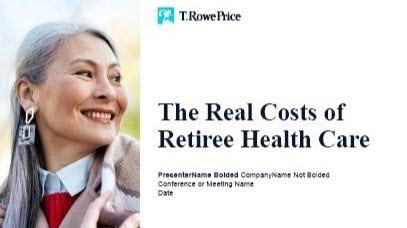Health Care
The Real Costs of Retiree Health Care
Historically, retiree health care costs have been a scary subject and a challenging financial puzzle. But our research and analysis helps take the guesswork out of planning.
Health Care
The Real Costs of Retiree Health Care
Historically, retiree health care costs have been a scary subject and a challenging financial puzzle. But our research and analysis helps take the guesswork out of planning.
The predominant narrative around health care costs in retirement is that they are overwhelmingly large, which can lead to anxiety and avoidance.
However, our research shows that health care costs can be effectively planned for and the conversation doesn't need to be as scary as previously thought.
Lost in the retiree health care discussion are key facts that bring the challenge down to size.
Source: T. Rowe Price Retirement Savings and Spending Study (2023).
Understand and plan for the costs
Projections for retiree health care expenses are often presented as lump-sum, lifetime figures. But actual costs are typically more modest, predictable, and best viewed as annual expenses. In reality, half of retirees will pay less than $3,500 annually, and only 10% will pay more than $8,300 annually.
Source: T. Rowe Price estimates based on 2024 Medicare premiums and data from the Health and Retirement Study (2020). All costs are rounded to the nearest hundred.
Focus on the typical; be aware of the extreme
In addition to total annual health care spending, retirees may experience health care “shocks” and end-of-life expenses.
- Health care shocks are an increase in out-of-pocket expenses over a two-year period.
- End-of-life spending is the amount spent over the last two years of life at the age of death.
Understanding what these expenses look like can help with planning. Typical expenses occur at the 50th percentile where half of retirees will pay less than $2,000 in health care "shocks" and $3,400 in end-of-life expenses. Only 10% of retirees are at the extreme and will pay more than $5,000 in health care "shocks" and $85,200 in end-of-life expenses.
Source: T. Rowe Price estimates from the Health and Retirement Study (2012-2018). Expenses are measured in 2022 dollars.
Take action
- Evaluate retiree health care funding vehicles. When it comes to planning and paying for retirement health care expenses, investors have multiple options to complement insurance coverage and help manage ongoing costs, including pretax accounts, Roth accounts, and health savings accounts.
- Account for Medicare. Medicare will be a key cost input so it's important to know the Medicare deadlines, understand the different Medicare coverage options, and incorporate Medicare choice into the planning process for your clients.
- Implement insights. Incorporate retirement health care costs and the nuances of retirement spending into the planning process, understanding that overall spending declines over the course of retirement when adjusted for inflation.
Put it into practice
Additional resources exploring important topics
Medicare
Learn more about Medicare coverage, enrollment, and the impact of Medicare expenses on retirement income.
Health Savings Accounts (HSAs)
Handouts highlight the importance of incorporating HSAs into a holistic retirement strategy.
Variable Annuities
Learn more about the health care landscape and how Variable Annuities can be used for health care expenses in retirement.
Learn more about the program and underlying insights
Contact Us
Broker-Dealer
877.561.7670
AdvisorServices@troweprice.com
RIA & Regional Bank
877.561.7670
AdvisorServices@troweprice.com
DCIO
800.371.4613
DCIO_Sales_Desk@troweprice.com
Variable Annuity
855.829.5343
VA_Sales_Desk@troweprice.com
202405-3568836

